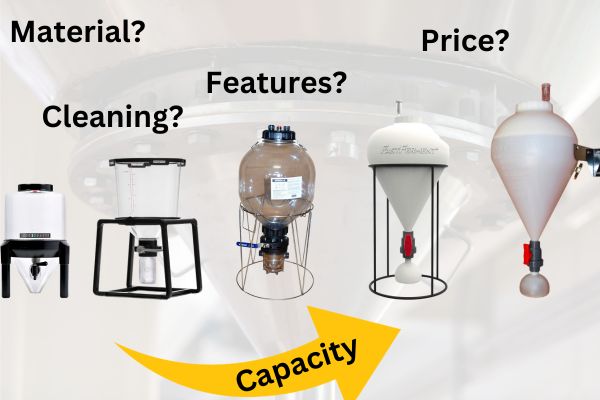When it comes to brewing, it’s hard to beat the satisfaction of working with wild yeast. Not only does it have a certain romantic appeal, but it can also produce some truly unique and flavorful beers. So, where can you find wild yeast for brewing?
The answer is simple: it’s all around you! In this post, we’ll explore the various places you can find wild yeast and how to collect and use it in your brewing endeavors.
1. Your Own Backyard
One of the most accessible sources of wild yeast is right in your own backyard. Yeast is naturally present in the air and on surfaces, so chances are there’s some suitable for brewing just outside your door.

To collect yeast from your backyard, try leaving a bowl of cooled wort (unhopped) outside overnight, covered with cheesecloth to keep out bugs.
The next day, bring the wort inside and let it ferment. You may need to try this a few times to find a yeast strain that produces a pleasant flavor, but the experimentation can be part of the fun.
2. Local Orchards and Vineyards
Fruit is a prime source of wild yeast, making orchards and vineyards excellent places to find strains suitable for brewing. In particular, apple orchards and grapevines are known to harbor diverse yeast populations.

To collect yeast from fruit, simply swab the surface of an apple or grape and then transfer the swab to a small amount of cooled wort. Alternatively, you can press the fruit to obtain juice and use that to inoculate your wort.
3. Nearby Forests
Forests are another great place to find wild yeast. Tree bark, leaves, and even soil can harbor a variety of yeast strains. To collect yeast from the forest, try swabbing tree bark or leaves and transferring the swab to a small amount of wort. You can also try burying a container with cooled wort in the soil and leaving it overnight to collect yeast from the ground.
4. Local Breweries and Homebrewers
If you’re friends with other brewers in your area, they may be willing to share their wild yeast strains with you.
This can be a great way to obtain tried-and-true strains that have already been proven to produce tasty beers.
Connecting with fellow brewers through homebrew clubs, online forums, or social media can be an excellent way to expand your wild yeast collection.
5. Commercial Yeast Labs
While it may not be as romantic as foraging for wild yeast in the great outdoors, commercial yeast labs are a reliable source of wild strains. Many labs offer a variety of wild yeast strains specifically selected for brewing purposes. This can save you time and effort compared to hunting for your own strains, but keep in mind that commercial strains may lack the unique local character you can get from foraging.
6. Fermented Foods
Many fermented foods, such as sourdough bread, kimchi, and kombucha, contain wild yeast. You can try using these foods as a source of yeast for brewing by adding a small amount to cooled wort. However, be aware that the results may be unpredictable, as the yeast strains in fermented foods may not be ideally suited for brewing.
7. Wildflowers
Wildflowers can also harbor yeast, making them another potential source for your brewing needs. To collect yeast from wildflowers, simply swab the petals or stems and transfer the swab to a small amount of wort. As with other foraged yeast sources, you may need to experiment with several different flowers to find a strain that produces a pleasant flavor in your beer.
8. Online Trading and Sharing
The internet has made it easier than ever to connect with fellow homebrewers and share yeast strains.
Websites such as The Yeast Bay and Milk The Funk Wiki allow users to trade or share wild yeast strains with other brewers.
This can be a great way to access unique strains from around the world and expand your wild yeast collection.
9. Be Creative!
The possibilities for finding wild yeast are only limited by your imagination. Yeast is everywhere, so don’t be afraid to think outside the box and try collecting it from unusual sources. Just remember to always practice good sanitation and be prepared for some trial and error as you experiment with different strains.
In conclusion, wild yeast for brewing can be found in a variety of places, including your backyard, orchards, vineyards, forests, fellow brewers, commercial yeast labs, fermented foods, wildflowers, and online trading websites.
By being creative and open to experimentation, you can discover unique strains that produce truly one-of-a-kind beers. To recap, here are ten quick facts about finding wild yeast for brewing:
1. Wild yeast is all around you, making it easy to find and collect.
2. Fruit, particularly apples and grapes, can be an excellent source of wild yeast.
3. Forests, tree bark, and leaves can harbor diverse yeast populations.
4. Fellow brewers can be a valuable resource for sharing wild yeast strains.
5. Commercial yeast labs offer a variety of wild strains specifically for brewing.
6. Fermented foods, such as sourdough bread and kimchi, can contain wild yeast.
7. Wildflowers can also be a source of yeast, though results may vary.
8. Online trading and sharing websites allow you to access unique strains from around the world.
9. Creativity and experimentation are key when searching for wild yeast.
10. Always practice good sanitation and be prepared for trial and error as you work with wild yeast strains.
FAQs
What is the best wild yeast for brewing?
There is no one “best” wild yeast for brewing as different strains can produce different flavor profiles and characteristics in the beer. However, some commonly used wild yeasts for brewing include Brettanomyces, Saccharomyces, and Lactobacillus.
Where can I find wild yeast?
Wild yeast can be found in the air, on fruits and vegetables, and in the environment around us. It can also be captured from sourdough starter or other fermented foods.
What is the best source of wild yeast?
The best source of wild yeast is the air around us, as it contains a variety of yeast strains that can be captured and used for fermentation.
Is wild yeast the same as natural yeast?
Yes, wild yeast and natural yeast are the same thing. They are both naturally occurring yeasts that can be found in the environment and used for baking and fermentation.
What is the best yeast for homebrewing?
The best yeast for homebrewing depends on the style of beer being brewed. Some popular yeast strains for homebrewing include American Ale yeast for pale ales and IPAs, Belgian Saison yeast for farmhouse ales, and German Hefeweizen yeast for wheat beers. It is important to choose a yeast strain that complements the desired flavor profile of the beer being brewed.
Can you find wild yeast?
Yes, wild yeast can be found in various places such as the air, soil, and on the surface of fruits and grains. However, it is important to note that not all wild yeast strains are suitable for baking or brewing, and some may even be harmful. It is recommended to use a reliable source of yeast for consistent and safe results.




